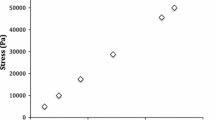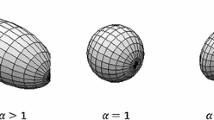Abstract
The use of normalized porosity in models for the porosity dependence of mechanical properties is addressed first for the frequently used power law expression for such dependence, i.e., E/E0 = (1−P)n where E is the property of interest at any volume fraction porosity (P) and E0 is the value of E at P = 0. Normalizing P by PC, the value of P at which the property of interest inherently goes to zero, giving E/E0 = (1−P/PC)n, clearly calls attention to the importance of PC values < 1 (e.g., potentially as low as ∼ 0.2), a fact long known but inadequately recognized. Serious problems from the arbitrary use of both n and PC as fitting parameters with little or no guidance as to the dependence that n and PC (which is microstructurally sensitive) have on the type of porosity are shown. Further, porosity normalization of the power law model indicates at best limited compression of different porosity dependences into a single universal porosity dependence function and little distinguishing of property dependences as a function of the type of porosity. However, normalized porosity of minimum solid area (MSA) models gives a single universal porosity dependence. The difference in responses to P normalization of the two modeling approaches is attributed to their being based respectfully on little or no pore character and on detailed pore character. Thus, P normalization may be a valuable tool for evaluating porosity models, but must be applied in a more rigorous fashion, i.e., PC determined primarily by measurement and correlation with the type of porosity (as with MSA models) and not as an arbitrary fitting parameter as used in the evaluations of the power law model.
Similar content being viewed by others
References
C. W. Bert, J. Mater. Sci. 20 (1985) 2220.
R. W. Rice, “Porosity of Ceramics” (Marcel Dekker, New York, 1998).
K. K. Phani, J. Mater. Sci. Lett. 5 (1986) 747.
K. K. Phani and S. K. Niyogi, J. Mater. Sci. 22 (1987) 257.
K. K. Phani and S. K. Niyogi, J. Amer. Cer. Soc. C-362-66 (1987).
D. C. Lam, F. F. Lange and A. G. Evans, J. Mater. Sci. 77(8) (1994) 2113.
T. Ostrowski, A. Ziegler, R. J. Bordia and J. Rödel, J. Mater. Sci. 81(7) (1998) 1852.
T. Ostrowski and J. Rödel, J. Mater. Sci. 82(11) (1999) 3080.
A. P. Roberts and E. J. Garboczi, J. Mater. Sci. 83(12) (2000) 3041.
A. R. Day, K. A. Snyder, E. J. Garboczi and M. F. Thorpe, J. Mech. Phys. Solids 40(5) (1992) 1031.
K. A. Snyder, E. J. Garboczi and A. R. Day, J. Appl. Phys. 72(12) (1992) 5948.
J. Kováčik, J. Mater. Sci. Lett. 20 (2001) 1953.
R. W. Rice, J. Mater. Sci. 31 (1996) 102.
R. W. Rice, J. Mater. Sci. 31 (1996) 1509.
L. Coronel, J. P. Jernot and F. Osterstock, J. Mater. Sci. 25 (1990) 4866.
P. A. Berge, B. P. Bonner and J. A. Berryman, Geophy. 60(1) (1995) 108.
D. J. Green, C. Nader, R. Brezny in “The Elastic Behavior of Partially-Sintered Alumina, Sintering of Advanced Ceramics,” edited by C. A. Handwerker, J. E. Blendell, W. Kaysser (Am. Cer. Soc., OH Westerville 1990) p. 347.
G. M. Tomilov, Tr. from Izvestiya Akademii Nauk SSSR, Neorganicheskie Materialy 13(1) (1977) 117.
J. N. Harris and E. A. Welsh “Fused Silica Design Manual, I,” NSC Special Publication (1973) p. 5.
P. Wagner, J. A. O’Rourke and P. E. Armstrong, J. Amer. Cer. Soc. 55(4) (1972) 214.
E. A. Belskaya and A. S. Tarabanov “Experimental Studies Concerning the Electrical Conductivity of High-Porosity Carbon-Graphitic Materials,” Institute of High Temperatures, Academy of Sciences of the USSR, Tr. from Inzhenerno-Fizicheskii Zhurnal (1971) Vol. 20, No. 4, p. 654.
B. Bridge and R. Round, J. Mat. Sci. 8 (1989) 691.
J. P. Singh, H. J. Leu, R. P. Poeppel, E. Van Voorhees, G. T. Goudey, K. Winsley and D. Shi, J. Appl. Phys. 66(7) (1989) 3154.
N. McAlford, J. D. Birchall, W. J. Clegg, M.A. Harmer, K. Kendall and D. H. Jones, J. Mat. Sci. 23 (1988) 761.
Rights and permissions
About this article
Cite this article
Rice, R.W. Use of normalized porosity in models for the porosity dependence of mechanical properties. J Mater Sci 40, 983–989 (2005). https://doi.org/10.1007/s10853-005-6517-0
Received:
Accepted:
Issue Date:
DOI: https://doi.org/10.1007/s10853-005-6517-0




